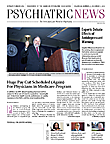The 2004 Food and Drug Administration (FDA) hearings on risk of suicidality in adolescents using antidepressants were crowded, tense, and widely reported by mainstream media, with some headlines—“FDA Links Drugs to Being Suicidal”(New York Times, September 14, 2004) and “How Paxil Killed Our Son” (New York Post, September 19, 2004)—destined to stoke public fears.
In the decade since an FDA panel approved a black-box warning about the increased risk of suicidality associated with adolescent use of antidepressants, that media coverage may have played a part no one anticipated. In 2005, Psychiatric News published what was believed to be the first analysis that showed a substantial decrease in antidepressant prescriptions for adolescents; the finding was replicated by other studies over the years, with at least one showing as well that the decrease in antidepressant prescribing was not accompanied by an increase in other forms of treatment (see box for list of research studies).
For many psychiatrists, the data would appear to vindicate APA’s long-held stance that the warning was a mistake, scaring parents from seeking treatment for their depressed children and clinicians from prescribing antidepressants.
Opinion is far from unanimous, however, and interviews with clinicians, former FDA officials, and health-services researchers reveal substantial differences about the appropriateness of the warning, its effects on patterns of prescribing, and possible effects on population health.
But from those interviews there did emerge consensus around a few points—that untreated depression is the most serious risk for suicide; that the FDA warning was never intended to discourage legitimate treatment of adolescent depression, a fact that may have been obscured by lay media reports that oversimplified a complex subject; and that better systems are needed for tracking risk factors for suicide and linking them to meaningful outcomes.
“The important point to keep in mind is that this warning was not intended as a contraindication,” said Thomas Laughren, M.D., who was team leader of the Psychiatric Drug Group within the FDA Division of Neuropharmacological Drug Products during the 2004 FDA hearings. “It was not the intent to discourage use, but to ensure that clinicians were aware of the need to monitor patients. I think it’s possible some people didn’t hear the message correctly, and the media didn’t help with that—there were some pretty inflammatory stories that came out around that time.”
Were There Unintended Consequences?
APA and its partners stressed from the outset that it was impossible to draw conclusions with respect to any causal link between antidepressant use and suicidality because the data the FDA had from its clinical trial registry did not come from studies prospectively designed to systematically define and identify the incidence of suicidal thoughts/behaviors in adolescents taking the medications.
But some psychiatrists are less convinced that the boxed warning was a mistake. Michael Thase, M.D., an expert on depression and antidepressant treatment and a professor of psychiatry at the University of Pennsylvania, stakes out what he calls a “middle ground.” He noted that APA (representing clinicians trained in the use of antidepressants and their potential side effects) and the FDA (which had to be responsive to public concern expressed during the 2004 hearings) have “different responsibilities and different vantage points.”
He emphasized that the boxed warning says nothing that contradicts wise clinical practice. “If you look carefully at the boxed warning, it is simply informing practitioners about the possibility of a relationship and providing generically good advice, such as to see patients for follow-up at close intervals, inform them about potential risk, and make sure they know about emergency services,” Thase said.
But Thase noted that the warning may have had unintended consequences. “A decrease in the prescription of antidepressants is one thing if there is an offsetting increase in the use of other effective interventions, such as cognitive therapy,” he said. “But there is no evidence that this actually happened. For primary care providers, decreasing antidepressant prescription appears to have resulted in no treatment instead of alternate treatment.”
Darrel Regier, M.D., former director of APA’s Division of Research, who testified against the warning in 2004, noted that the original boxed warning came with explicit, highly prescriptive recommendations for the frequency of visits that should be made with children or adults started on antidepressants; these included weekly visits for the first four weeks, then visits every two weeks, followed by monthly visits.
“Primary care physicians who rarely saw patients frequently considered themselves liable to suit if patients had an adverse effect from the antidepressant medication or died if the physician didn’t follow that protocol,” Regier said.
Increased Caution Was One Result
In a subsequent version of the warning, this explicit guidance was dropped and an additional note was added that major depression is a serious illness and the most common risk for suicide.
Others, such as Mark Olfson, M.D., of Columbia University, said that although there was indisputably a change in prescribing patterns attributable to the warning, it was primarily a decline—or a levelling off—in prescribing by primary care physicians treating less severely ill patients, relative to a very sharp increase in years preceding the FDA warning. “The effect of the boxed warning may have been primarily to increase caution among primary care providers about use of antidepressants in patients with less-severe symptoms,” he said.
His position was echoed by Michael Schoenbaum, Ph.D., senior advisor for mental health services, epidemiology, and economics in the Office of Science Policy, Planning, and Communication at the National Institute of Mental Health. He noted that primary care physicians became much more inclined to prescribe antidepressants with the advent of SSRIs.
“When pharmacotherapy for depression mainly involved tricyclic antidepressants, before SSRIs became available, primary care providers were generally uncomfortable prescribing tricyclics, because they were difficult to dose and titrate and presented risks of serious side effects,” Schoenbaum told Psychiatric News. “SSRIs, while similarly efficacious to tricyclics, are much safer, so when they became available, primary care providers became increasingly willing to treat depression.
“Broadly, the case mix of patients presenting with depressive symptoms in primary care is less severely ill than patients presenting or being referred to psychiatry,” he noted. “So, as primary care providers became more familiar with SSRIs, I think patients with subthreshold depression, who previously might not have received active treatment, now received antidepressant treatment via primary care.”
Regier countered that although the average severity of depression in patients seen in primary care practices is less than that seen in psychiatric settings, there are actually more people with severe depression treated in primary care settings than are treated by psychiatrists. “Although we now know from clinical trials that patients with mild to moderate depression do as well or better on CBT [cognitive-behavioral therapy] than on antidepressant meds, there is often a failure to treat those with moderately severe to severe depression in those settings because of a hesitancy to use antidepressant medications and the absence of referral sources for CBT or medications to specialists.”
Clinicians on the front line agreed that some of the headlines in lay media reports about the issue likely acted as a wildcard that the FDA could not have anticipated.
“My own sense is that the extensive media coverage of the hearings probably had more of an impact on practice patterns than the black-box warning itself,” said child psychiatrist and past APA Board member David Fassler, M.D. “Front-page articles in major national publications and extensive TV and radio coverage created the general impression that the use of SSRI antidepressants actually increased the risk of suicide in children and adolescents. Although this was not the FDA’s conclusion, it was the coverage most people saw and heard. As a consequence, many parents and physicians became reluctant to use these medications.”
At the heart of the debate around the boxed warning on antidepressants is the complex relationship between suicidality and treatment or lack of treatment. Some cite evidence that the suicide rate among adolescents rose in 2004, the year the warning went into effect, for the first time in 15 years. One recent study in the British Medical Journal linked the boxed warning to an increase in suicide attempts, as measured by “psychotropic poisonings.”
But that study has been widely criticized for methodological problems, especially its use of psychotropic poisonings as a proxy for suicide attempts. Olfson insisted that whatever the change in prescribing, it is not clear that any population-health effect in terms of suicide and self-harm can be causally related to the warning. “Claims that there was such an effect do not stand up to careful scrutiny,” Olfson said.
Laughren noted, “Suicide is such a complicated behavior related to so many things—the economy, the availability of means for killing oneself—it is unwise to try to link something as discrete as prescribing to a behavior as complicated as suicide.”
Schoenbaum agreed but added an important caveat. “The available population-based data are limited in many important ways, so the absence of evidence is not the same as definitive proof to the contrary,” he said. “At the same time, people who advocated for the warning argued that more careful prescribing of antidepressant medication would reduce suicidality. To my knowledge, available population-based data do not support these hopes either.”
On this point, he is emphatic, and it is one with which people on both sides of the debate would agree: the systems for tracking risk factors for suicide and reliably linking them to outcomes are lacking.
Regier predicted a move toward more systematic reporting by the FDA as it begins to have access to electronic health records used by large health systems and with the incorporation of the Columbia Suicide Severity Rating Scale for use in future phase 3 clinical trials with any drug thought to have a potential for suicidal ideation.
Understanding suicide at the population level is complicated, Schoenbaum said, because the questions are complicated: What are the correlations among certain kinds of predisposing factors (depression, anxiety, and other mental illnesses), certain kinds of behaviors, various kinds of treatment (or lack of treatment), and actual suicide attempts or completed suicide?
“It’s a very important question from a public-health perspective, but the data one needs to understand what is going on are not good,” Schoenbaum said. “We still don’t have systems in place to be able to address these concerns in any definitive way.” ■


